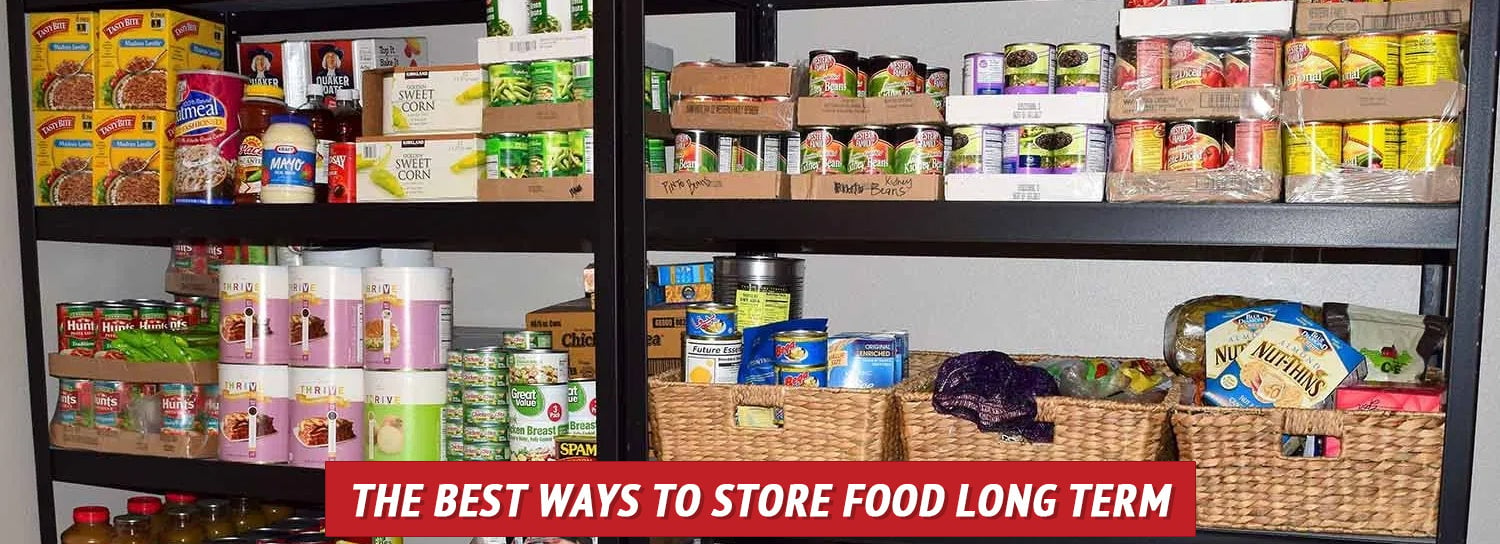
Unfortunately, even those of us who take food preparedness seriously may not be storing our long-term food supplies properly. Long-term food needs to be safely stored or else an entire supply can be ruined.
That’s why a stockpile of canned goods from the grocery store may not actually help you when you need it—the same goes for emergency food kits in unsealed containers like plastic totes.
Keep reading for the best ways to store food so you don’t risk losing the supplies you’ve worked so hard to stockpile.
The Basics of Long-Term Food Storage
Whether you are storing emergency food for just a few days or preparing for a much longer event, there are some basics you need to know.
- Food lasts when it is properly stored in the right containers. Many shelf-stable foods are not sold in containers that keep them safe for years. Foods should be stored in material that keeps water, light, bugs, and rodents out.
- Food storage needs to be rotated. Many food stockpiles are not designed to be bought and forgotten. They need to be rotated on a regular basis.
- During an emergency, eat food stored the longest, first. Don’t pick and choose freely. Stick to the “first in, first out” rule.
- Environment matters. The storage environment greatly affects the actual shelf life. Most long-term foods do best in a dry, cool, dark location at temperatures between 55°F and 70°F.
Seal Out Oxygen, Moisture, Light, & Pests with Food-Grade Buckets
It’s critical to make sure you keep food storage safe from oxygen, rodents, insects, and light. This is why you must take an additional step other than just storing food in the traditional mylar bags or foil pouches. Containers like storage totes, for example, are insufficient. They’re full of unsealed openings that can let a whole host of contaminants in.
As Caltex Plastics explains, “Rodents can gnaw through a large variety of materials. If you use foil pouches for food storage, keep the bags in food-grade plastic buckets. These buckets will seal out even more oxygen and light and will keep rodents and insects from contaminating your food stores. If sealed properly and stored in ideal conditions, food kept in plastic buckets can last up to five years or even 20 years if oxygen absorbers are used” (emphasis added).
In addition to buckets, #10 cans also provide robust protection against oxygen, moisture, light, and pests. With rugged metallic walls and sealed tops, they can keep food fresh for decades.
Spread Your Supply Across Different Locations
Keeping your entire supply in one location is akin to putting all your eggs in one basket. It makes your cache more vulnerable to disasters and theft.
For example, portions of your home could collapse in an earthquake or burn in a fire. If the damaged area also happens to be where you keep your emergency food, you may not be able to access it when you need it most.
For that reason, it’s recommendable to split up your food supply and store it across a few locations you can easily access. Putting a few buckets in your pantry, under the kitchen counter, in a bedroom closet, in an insulated shed in the yard, etc., helps ensure you won’t be cut off from food in most situations.
Knowing the Difference in Expiration Dates

Do you know the difference between a food’s “sell by,” “best by,” or “use by” dates? If not, you’re not alone. Most Americans don’t, which is how long-term food storage can become even more complicated.
According to Georgia Giannopoulos, RD, CDN, CNSC, a dietitian at the Weill Cornell Medical Center for Cornell University, “These terms are more about the food’s quality than safety. A ‘best if used by’ date marks when the food should be consumed for the best flavor or quality. A ‘sell by’ date marks how long a store can sell a product. A ‘use by’ date marks the last date to use the product while at peak quality, but many foods are still safe to consume after this date.”
Ultimately, many shelf-stable foods are still considered safe to eat long past their expiration dates. But that doesn’t mean they can last forever.
Advantages of My Patriot Emergency Survival Food Buckets
 Reading all of the information above might feel a bit overwhelming. Long-term food storage can be a lot of work – but it doesn’t have to be. Some survival companies, such as My Patriot Supply, sell bulk long-term emergency food making it easy to get all the items you need at one time and place.
Reading all of the information above might feel a bit overwhelming. Long-term food storage can be a lot of work – but it doesn’t have to be. Some survival companies, such as My Patriot Supply, sell bulk long-term emergency food making it easy to get all the items you need at one time and place.
It’s important to not only pay attention to the quality of the food the company produces, but to also look into its packaging. Other survival companies use unsealed totes for their long-term food kits. Unless you purchase additional storage supplies, there’s a chance this food could go bad after just a few years (even when stored in a cool, dark place).
In comparison, My Patriot Supply’s long-term emergency food comes in resealable, heavy-duty four-layer pouches with oxygen absorbers inside to extend shelf life, and it’s all stored inside a water-resistant bucket.
This means you get a food supply that is designed to last for up to 25 years! Plus, the buckets are easy to stack for convenient storing, and some self-reliant consumers have even been known to bury their buckets to keep their food cache extra safe.
Make long-term food storage a priority, friends.
In liberty,
Elizabeth Anderson
Preparedness Advisor, My Patriot Supply



